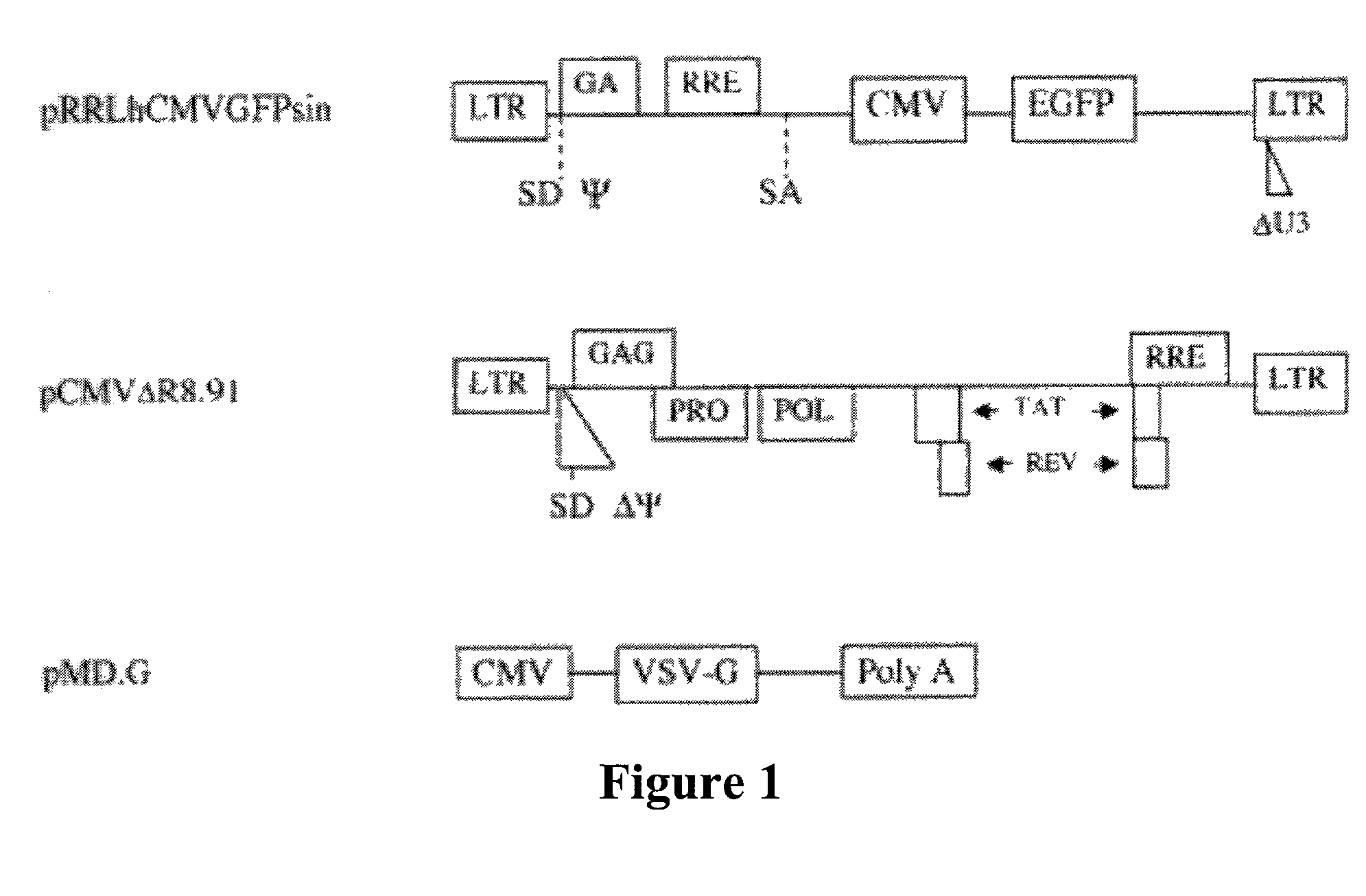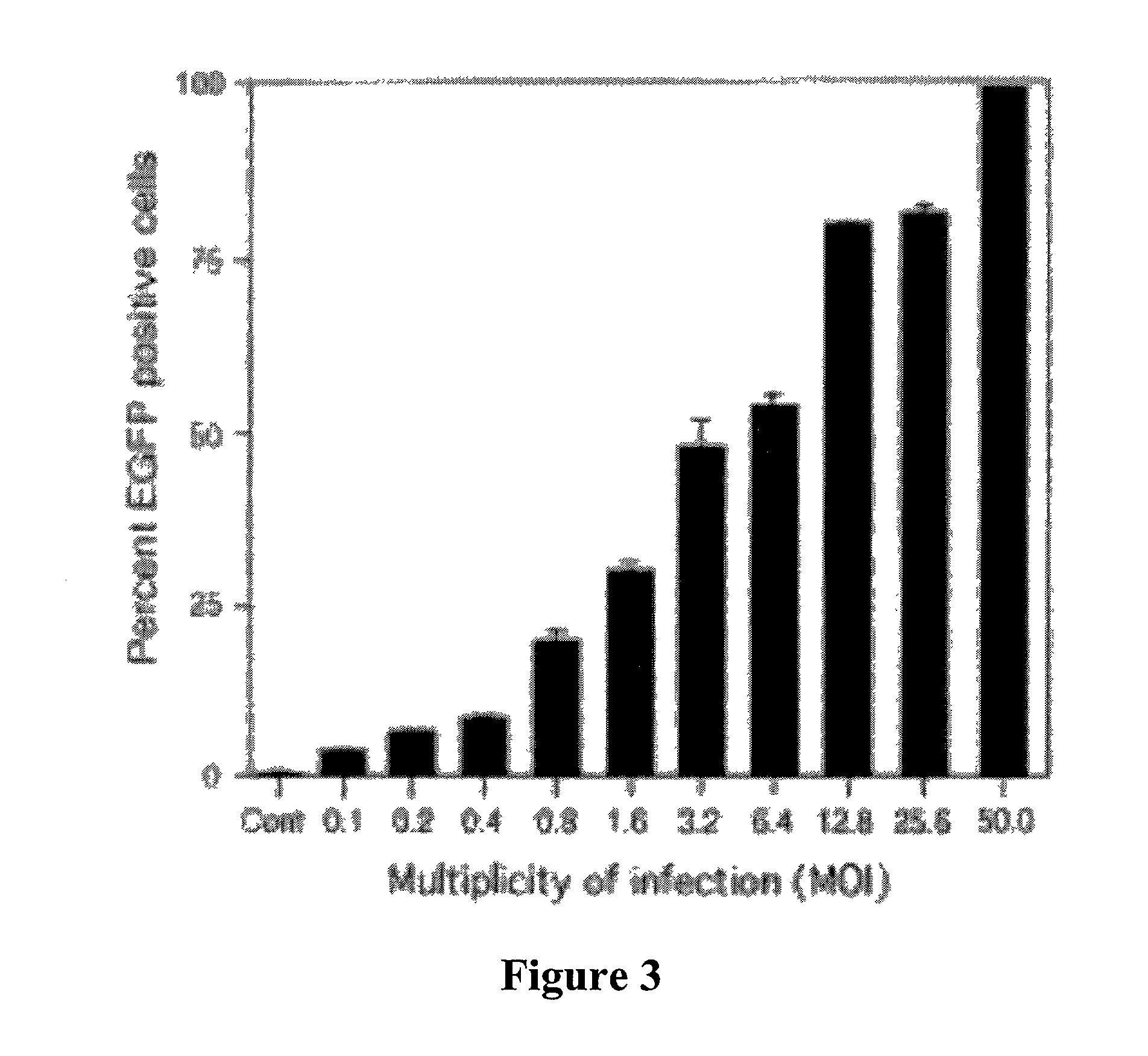Lentivirus vectors for gene transfer to alveolar epithelial cells
a technology of alveolar epithelial cells and lentivirus, which is applied in the direction of viruses/bacteriophages, biocide, genetic material ingredients, etc., can solve the problems of low transduction efficiency, inability to achieve long-term expression in the distal respiratory tract, etc., to achieve high titers and easy concentration of virus in high titers
- Summary
- Abstract
- Description
- Claims
- Application Information
AI Technical Summary
Benefits of technology
Problems solved by technology
Method used
Image
Examples
example i
Lentivirus Vector for Gene Transfer to Alveolar Epithelial Cells
[0048]Recombinant lentivirus vector and packaging constructs were generously provided by Dr. L. Naldini (University of Torino, Italy) and produced as described in (34). A self-inactivating replication defective human lentiviral (HIV) transfer vector expressing enhanced green fluorescent protein (EGFP) from the cytomegalovirus (CMV) immediate early promoter was used. Human 293T cells were co-transfected by calcium phosphate precipitation at 80–90% confluence with 12 μg pRRLsin.hCMVGFP, 10 μg pCMVΔR8.91 for viral packaging and 8 μg pMD.G for VSV-G pseudotyping. The vectors used for generation of lentivirus are shown in FIG. 1. Virus was isolated and for some experiments was concentrated through a Macrosep™ centrifugal concentrator (Pall, Gelman Sciences, Mich.) with a 300 kDa molecular weight cutoff and stored at −80° C. Vector stocks were tittered on HeLa cells by flow cytometry and were in the range of 106–108 TU / ml. ML...
example ii
In Vitro Transduction of Alveolar Epithelial Cells Using Lentivirus
Rat Alveolar Epithelial Cell Isolation and Culture
[0049]Type II (AT2) cells were isolated from adult male Sprague Dawley rats by disaggregation with elastase (2.0–2.5 U / ml) (Worthington Biochemical, Freehold, N.J.) followed by panning on IgG-coated bacteriologic plates. Enriched AT2 cells were resuspended in growth medium (MDSF) comprised of Dulbecco's modified Eagle's medium and Ham's F12 nutrient mixture in a 1:1 ratio (DMEF-12: Sigma Chemical, St Louis, Mo.), supplemented with 1.25 mg / ml bovine serum albumin (BSA) (Collaborative Research, Bedford, Mass.), 10 mM Hepes, 0.1 mM nonessential amino acids, 2.0 mM glutamine, 100 U / ml sodium penicillin G, and 100 μg / ml streptomycin and 10% newborn bovine serum (Omega Scientific, Tarzana, Calif.). Cells were seeded onto plastic, chamber slides or tissue culture-treated polycarbonate (Nuclepore) filter cups (0.4 μm pore size, 1.1 cm2 diameter; Transwell; Coming-Costar, Camb...
example iii
In Vivo Gene Transfer Through Lentivirus Vector Transduction in Mammalian AEC
[0067]Adult rats were anesthetized by ketamine / xylazine administered intramuscularly. Vocal cords were visualized using an ear-piece attached to an otoscope. A flexible catheter (diameter 1.2 mm) was inserted into the trachea under direct visualization. 250 μl lentivirus vector containing GFP or saline solution was injected followed by 0.5 cc air bolus into the lungs. The animals were wrapped in a warm blanket and allowed to recover. Food and water were provided ad lib. 48–72 h later, animals were sacrificed and the lungs were harvested to analyze expression of a GFP reporter gene by immunocytochemistry, mRNA and protein analysis.
[0068]Immunohistochemistry and western analysis (FIG. 6) illustrate that the reporter protein was expressed in the lungs of rats infected with the lentivirus.
PUM
| Property | Measurement | Unit |
|---|---|---|
| Time | aaaaa | aaaaa |
| Time | aaaaa | aaaaa |
Abstract
Description
Claims
Application Information
 Login to View More
Login to View More - R&D
- Intellectual Property
- Life Sciences
- Materials
- Tech Scout
- Unparalleled Data Quality
- Higher Quality Content
- 60% Fewer Hallucinations
Browse by: Latest US Patents, China's latest patents, Technical Efficacy Thesaurus, Application Domain, Technology Topic, Popular Technical Reports.
© 2025 PatSnap. All rights reserved.Legal|Privacy policy|Modern Slavery Act Transparency Statement|Sitemap|About US| Contact US: help@patsnap.com



